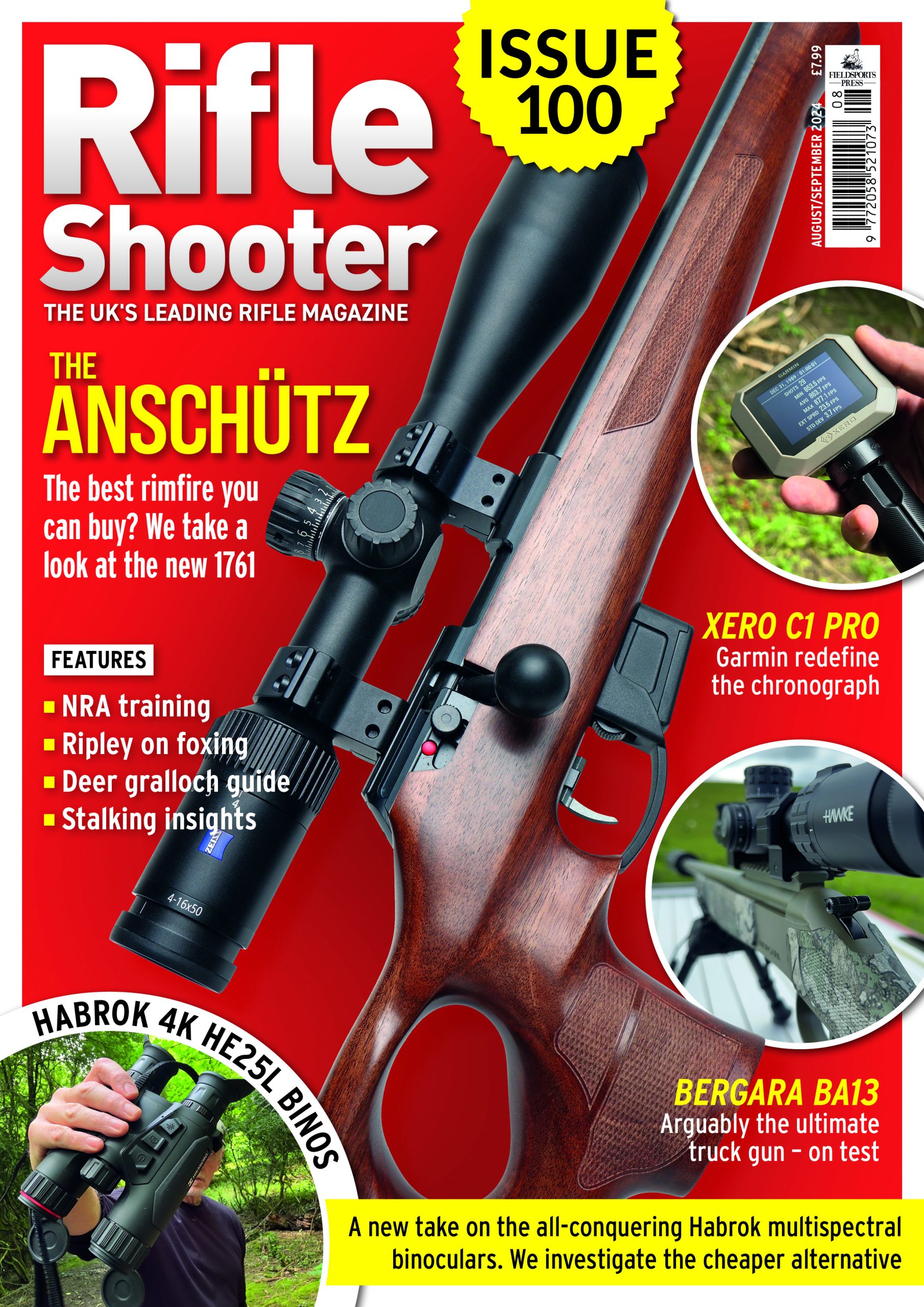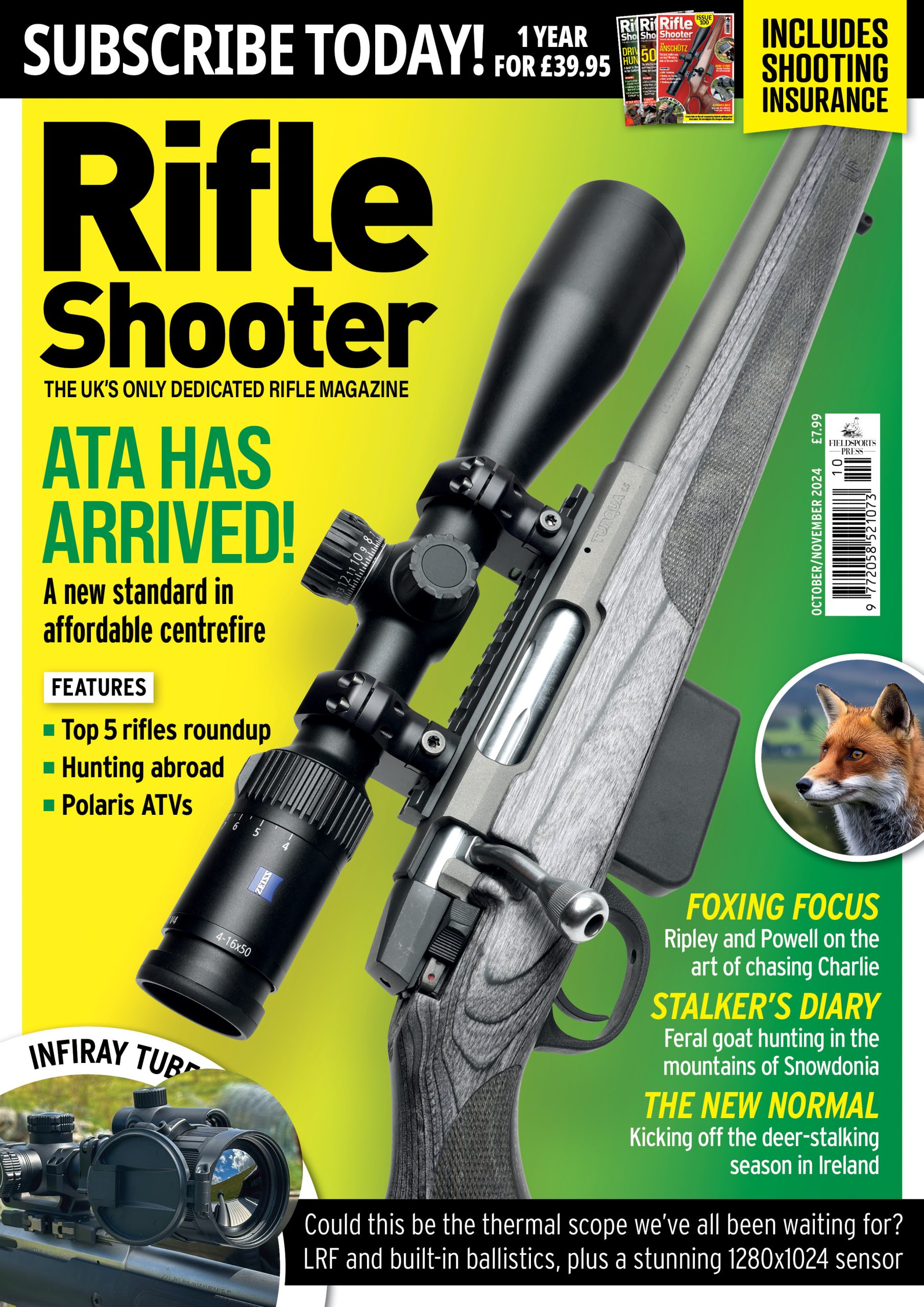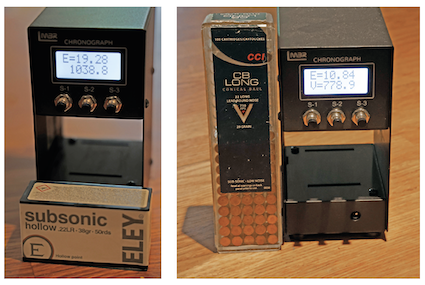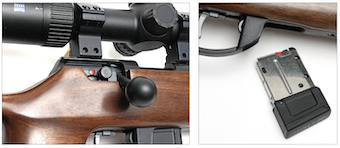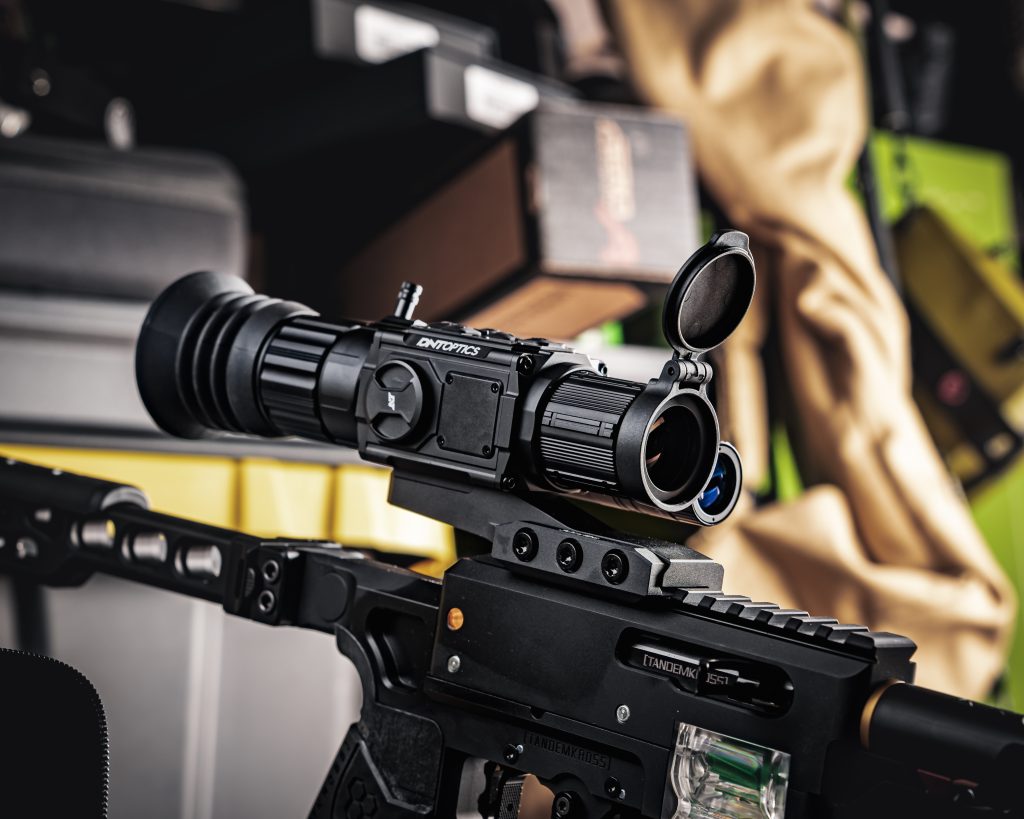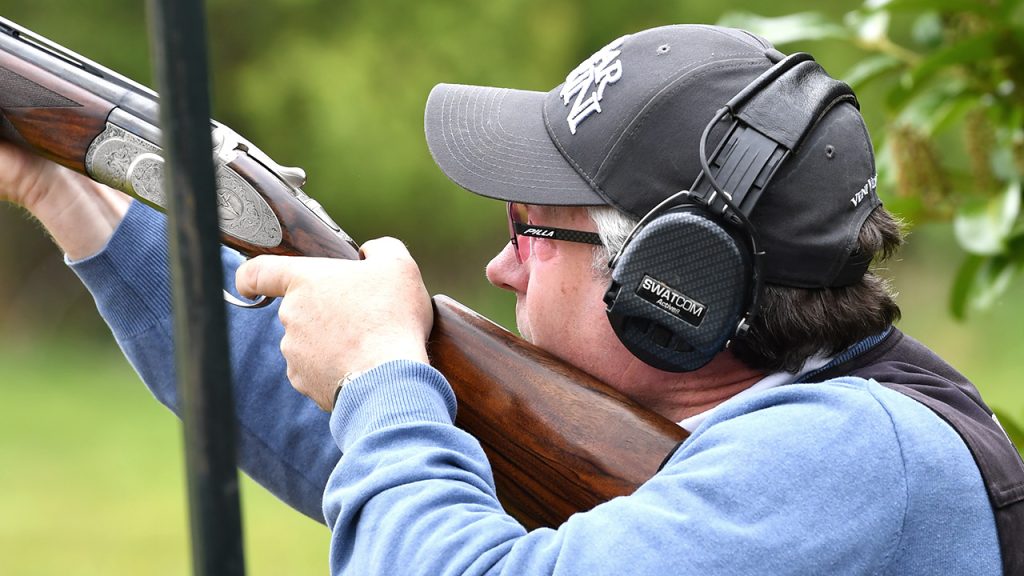Anschütz 1761 Thumbhole
Bruce Potts discovers how well the lightweight and ergonomic Anschütz 1761 thumbhole is designed for the field, providing superb accuracy and handling.
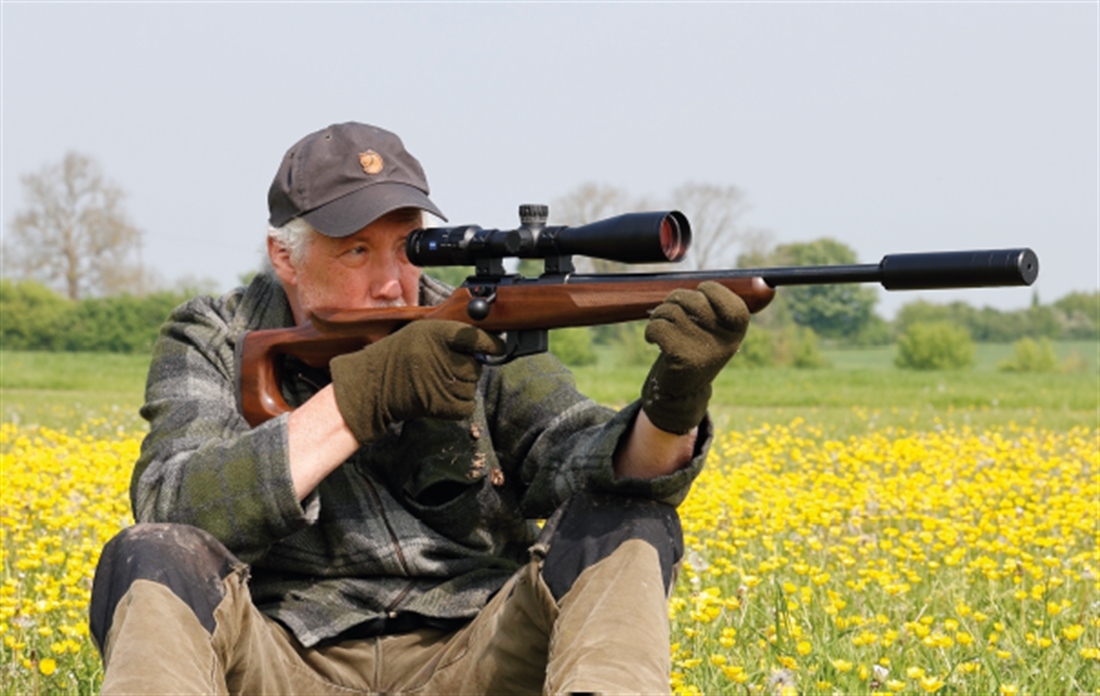
High-end rimfire rifles have always appealed to discerning shooters, with those from Anschütz being at the top of the list. This demand stems mainly from their build quality and accuracy, achieved over decades of development with the legendary barrels of their target rifles.
The company’s newer model 1761 continues that long tradition while adding some new features and manufacturing techniques. It’s a worthy successor to the rounded action designs of older Anschütz rimfires. This thumbhole version in particular raises the stakes further with its lightweight, ergonomic and well-crafted design. In fact most Anschütz rimfires feel like a full-bore rifle but in a more svelte overall package. They are by no means cheap at £1670, but it is German rifle and quality costs.
SPECIFICATIONS
The stock of any rifle is what will instantly catch the eye of any would-be purchaser, making it essential to get right visually as well as ergonomically. German makers tend to emphasise the latter quality. On this rifle the walnut is a higher grade than on the Classic model with, an overall honey coloured tone accented by horizontal figuring. I have tested versions with considerably better walnut, so I suppose it’s just the luck of the draw.
The oil finish is very well applied and looks and smells excellent. It is a very practical stock finish for field use as it wears well, repels moisture and is easily topped up to replenish any worn areas. A simple black recoil pad and black plastic spacer give a very steady grip once the rifle is shouldered. The length of pull is generous at 14¾” and the trigger blade position is adjustable for perfect positioning of the blade to the finger tip, thus aiding in correct trigger release and consistency.
What the thumbhole contours lack in instant visual appeal they gain in masterful design. First, the very upright nature of the pistol grip affords a natural and fatigue-free hold, with grooves serving to position your trigger finger correctly. It is, however, very right-handed in design, with no left-handed options on this model (Classic and MPR models offer a left hander), But due to its near perfect balance and stable geometry you can shoot it left handed if really necessary.
Anschütz have opted for a skeletonised look for this rifle, which serves two purposes. The first is visual, giving a modern impact; the second is an obvious reduction in weight. The rear section of the stock has a large asymmetrical cutout but still retains the all-important top wood section of the thumbhole above the pistol grip for strength.
The comb is straight and flat with a well-defined cheek piece to the left side only. I found it a perfect height and length for the Zeiss scope fitted for testing. I also like the fact that the front portion of the pistol grip encapsulates the rear of the trigger guard, as it not only looks better than the Classic model but is more comfortable for your trigger finger.
Comfort continues in the form of the long, slim forend, which terminates with a semi-Schnabel tip. The barrel channel is sufficiently wide to enable a free-floated barrel. Although the chequering to the pistol grip and forend is quite grippy, its actual definition and coverage is a bit lacking in my view. Sling swivel studs are fitted as standard.
Overall the thumbhole design on this 1761 is very well thought out and, as one would expect from Anschütz, provides great handling. I like the fact that the cutout section is not just sawn out; the edges are scalloped and softened, and although it isn’t the best-looking thumbhole it is certainly one of the best handling.
Now to the heart of this rimfire – the new 1761 action. It has the boxier look that manufacturers prefer today. Gone is the more traditional rounded and sleek profile of the older 54 model but the Anschütz mechanical smoothness and reliability still remain.
It is more compact and wears a satin blued finish rather than the polished shine of old. The 11mm twin dovetail rails still remain for scope attachment, although a one-piece Picatinny rail is an optional extra. There is plenty of room for and aft of the ejection port for correctly fitting a scope to your eye relief. One thing to note is that scope mounts that have protruding tightening screws should be fitted facing on the left side of the action to prevent them from fouling the bolt operation.
The bolt has a newer configuration whereby the handle now sits halfway along the bolt body and not at the end. This keeps the bolt throw and handle within the confines of the action body itself. Only the rear bolt shroud and red cocking indicator protrude.
The twin locking lugs are positioned at a 120° apart where the bolt handle joins the main body of the bolt. This forms a very solid and consistent bolt lock up and I also surmise contributes to the 1761’s super fast and slick bolt operation. The 4¾” bolt has a very short travel, so chambering or ejecting a round is accomplished within an inch. The handle is straight and has a generous plastic knob for easy operation. I also like the twin opposed extractor claws that ensure speedy and reliable cartridge exit from the chamber. The bolt is easily removed via a single button to the left rear of the action.
Other structural changes have been the redesigned trigger guard, which although allowing a good degree of movement and space around the trigger blade is a tad ugly. At least with the thumbhole design the rear section is covered up! It’s made of polymer, which is no bad thing as it will not rust, but Anschütz do offer an aluminium upgrade so must know it’s a feature some may wish to change. A good feature is the relocation of the magazine release, which now sits within the guard and takes the form of a well-sized, grooved button.
A five-shot magazine is supplied with the 1761, but 10-shot versions are available. They are nicely made, with the upper half aluminium and the lower polymer. Being a single-stack feeding system, they are very reliable and the red polymer follower accurately positions the new round for each chambering.
The side-mounted, rocker-type safety is simple and positive in operation. When the rifle is cocked the lever can be moved rearward to cover the exposed red dot. At that point the sear is disengaged but the bolt can still be opened to expel a loaded round if necessary.
The trigger is the 5061 D light unit, which has a two-stage movement, unlike the similar 5061 L model, which has a single-stage pull. This D model also has an adjustable blade that moves fore and aft and side to side from its cylindrical hanger. I usually like single-stage triggers, but this model with its slightly straighter blade and light first pull of just 4oz allows you to finely differentiate between each stage, so the second stage breaks ultra cleanly at a very light 9.5oz.
Finally – the barrel. Anschütz, with their decades of match-winning rifles, can be relied on to produce some of the best barrels in the world. This one has a fine chrome moly construction with satin blued finish and is available in .22 LR as tested, with other calibres being .17 HMR and .22 WMR, which is still hanging on. Barrel length is a very sensible 18″, and with its 20mm profile is slightly stiffer than a normal sporter-type barrel.
Its match-like chambering and 1 in 16″ rifling twist rate certainly gets the best out of a vast majority of rimfire ammunition types, weights and speeds. The muzzle crown is well recessed to avoid damage to the emerging rifling lands and has a ½” UNF thread for a moderator. The thread is cut precisely and the moderator fitment is very snug, with perfect bore axis-to-baffle alignment offering the best accuracy as well as noise reduction.
FIELD TEST
I fitted a Zeiss V4
4-16x50mm scope, which is one of the best all-round rimfire scopes on the market. For a spot of silent shooting, a Wildcat Panther over-the-barrel moderator was fitted. It’s a
great lightweight and effective sound moderator, whose screw thread can be changed to different pitches for extra versatility.
I stuck to subsonic ammunition as this is where the 1761’s abilities as an accomplished vermin gun lie. Best accuracy went to Eley hollow point and their slightly lighter than average 38gr lead bullet. Groups ran at 0.53″ at 50yd for five shots at 1041fps and 92ft-lb energy.
CCI Segmenting ammunition, with its 40gr hollow point, shot 1047fps and 97ft-lb with 0.71″ groups. Hot on its heels accuracy-wise were the Norma Subsonics with 0.76″ groups, but they were much quieter with 974fps velocity and 84ft-lb energy.
I love the CCI Suppressors as their heavier 45gr hollow point design offers great down-range energy transfer. They were accurate, too, with 0.64″ groups at 943fps and 89ft-lb energy. Finally for the normal subsonic ammo was the good old Winchester Max, with its 42gr hollow point projectile. I had 0.69″ groups at 1048fps for 103ft-lb energy.
I also tried my usual assortment of reduced loads, which I favour around the farmyard. Best of the bunch were the CCI CB Long, but at a reduce maximum range of 20yd with 0.78″ groups at 753fps/36ft-lb from its 29gr projectile. They were very quiet with the Wildcat Panther moderator fitted.
RWS Z Lang bullets are normally very accurate at 20yd but only managed a group of 0.9″. Still, they were superbly quiet due to their low velocity of 847fps and generated a more than adequate 46ft-lb. That’s FAC air rifle territory. Both of these reduced loads have a round nose design, so you need to have a very safe backdrop.
HUNTING
Now for the real test of any rifle designed for hunting – an evening’s rabbiting. Its overall length allows easy passage through foliage and the lightweight stock made it no bother to tote about. It can be quite difficult to detect rabbits at this time of year, with the grass, crops and foliage so luxuriant, but I managed to sneak to a shallow rise in the centre of a five-acre paddock and saw numerous rabbits at distances of 30-75yd.
Prone and unsupported, the 1761 felt well planted and the thumbhole stock design is such that a natural grip affords a rock-steady aim as well as great trigger control. A bunny at 40yd toppled to a head shot silently enough that I had time to reload a second round and bag another that had run and stopped 20yd from me! This Anschütz is so clinical in its delivery of bullets downrange that further shots even out to 75yd were instinctive and well within its capabilities. I ended the evening with seven rabbits and an unlucky magpie that had landed to peck at a downed bunny.
CONCLUSIONS
There is no denying the accuracy and great handling this 1761 offers, and although I might have my own ideas of what makes a nice-looking thumbhole, this Anschütz is a without doubt a very practical and comfortable rimfire to shoot in the field. It delivered excellent accuracy with all the loads tested, with great reliability. It’s a bit pricey, but then it is an Anschütz with a match-grade barrel and one of the best triggers on a rimfire. You decide.
Related Articles
Get the latest news delivered direct to your door
Subscribe to Rifle Shooter
Elevate your shooting experience with a subscription to Rifle Shooter magazine, the UK’s premier publication for dedicated rifle enthusiasts.
Whether you’re a seasoned shot or new to the sport, Rifle Shooter delivers expert insights, in-depth gear reviews and invaluable techniques to enhance your skills. Each bi-monthly issue brings you the latest in deer stalking, foxing, long-range shooting, and international hunting adventures, all crafted by leading experts from Britain and around the world.
By subscribing, you’ll not only save on the retail price but also gain exclusive access to £2 million Public Liability Insurance, covering recreational and professional use of shotguns, rifles, and airguns.
Don’t miss out on the opportunity to join a community of passionate shooters and stay at the forefront of rifle technology and technique.
